
The Hanyu Shuiping Kaoshi, or Chinese Proficiency Test (HSK), is an internationally administered test assessing non-native Chinese speakers’ competency at using the language. For Chinese learners, the HSK is a big deal because of its international recognition, its credibility, and the fact that HSK certificates open doors to lucrative academic and professional opportunities. HSK exams consist of listening, reading and writing elements; this article will focus on preparing for the HSK reading test, for which it is essential to have access to appropriate sources of Chinese reading material.
Originally comprised of six levels, three additional HSK levels have been added as of 2022; however, achieving HSK6 is still considered to be sufficient for most people using Chinese in their everyday personal and professional lives, and HSK7+ is primarily of interest only to serious scholars of the language. Therefore, for the purposes of this article we will concentrate on HSK levels 1 to 6.
What to expect in the HSK reading test
Every level of the HSK contains a reading element and a listening element. HSK3 and above also contains a writing element. (Speaking is assessed in a different exam, known as the HSKK.) The focus of this article is solely the HSK reading part – so let’s take a closer look at what it involves, followed by some recommended sources of Chinese reading material and some helpful HSK tips.
HSK Beginner (Level 1 and 2)
At the beginner levels, a knowledge of Chinese characters is not yet required, as the written Chinese is supplemented by pinyin. (However, it’s never too early to start learning characters!) Broadly speaking, the HSK reading tests for levels 1 and 2 consist of:
- Matching words and pictures or pictures and simple sentences
- Matching pictures with corresponding short dialogues
- Matching questions and answers
- Multiple-choice gap-fills
- True-or-false questions
HSK Intermediate (Level 3 and 4)
At HSK3 level and above, no pictures or pinyin are included, so the candidate must rely solely on their knowledge of Chinese characters. As you would expect, the reading questions become progressively more complex, but the activities are not too different from levels 1 and 2, including:
- Multiple-choice questions based on sentences, dialogues and short texts
- Multiple-choice gap-fills
- Rearranging sentences into a logical sequence
HSK Advanced (Level 5 and 6)
At the advanced levels, the candidate is required to possess a rich, sophisticated vocabulary and an extensive knowledge of Chinese characters. In the reading test, longer texts comprised of several paragraphs are presented, followed by multiple-choice comprehension questions. Gap-fill exercises are still present but they are yet more complex, consisting of multiple words or longer phrases to choose from. At these levels it is essential to be able to read Chinese quickly and fluently and to understand nuance and detail in a text.
Where to find HSK reading material
Graded news in Chinese
For a vast collection of HSK reading material, graded by HSK level and updated daily, look no further than The Chairman’s Bao graded news. The article topics are diverse – from business to science to pop culture and much more – which means that readers are exposed to new vocabulary every day and are able to select reading material according to their interests. There is a host of helpful features which make the site/app very learner-friendly, such as:
- The option to turn pinyin on or off
- The ability to enlarge the text or increase the space between words for readability
- Audio recorded by native speakers
- Inbuilt dictionary with a one-click “save” feature allowing users to add to their word bank
- Integrated grammar lessons
- Reading and listening exercises for Chinese comprehension practice
Short stories and dialogues in Chinese
Du Chinese is a hugely popular app for accessing Chinese reading material. It includes short stories and dialogues which reflect everyday life and are relevant to the HSK exam. The content is categorised by level (from “Newbie” up to “Master”) and by topic, and the app has a wealth of features, including:
- A one-tap dictionary
- Optional pinyin
- Complete English translations
- Native speaker audio recordings with a karaoke-style word highlight feature
- The ability to save words and create flashcards
Graded Chinese stories via email
Another handy tool for HSK reading practice is Maayot. Users can select their level (beginner / intermediate / advanced), sign up with their email address, and get graded Chinese stories sent to their inbox. Paid subscribers get a daily story, plus access to comprehension quizzes and a one-tap dictionary. The free option is limited to one story per week and none of the additional features.
Digital library of HSK reading material
The app Readibu boasts an extensive library of Chinese novels, short stories and children’s stories available to read online, categorised by HSK level. It has many features in common with other Chinese language-learning apps, including optional pinyin and inbuilt audio. One additional distinctive feature is the ability to enter a custom URL and convert any publicly available online content into the Readibu format for easy reading.
How to improve Chinese comprehension
Vocabulary
It goes without saying that vocabulary is the bedrock of reading comprehension; if you don’t know the words in a text, how can you possibly derive meaning from it? And it’s frustrating to discover that, if even one Chinese word in a sentence is unfamiliar, it can interrupt the flow of reading and make comprehension difficult if not impossible. Thankfully, your path to learning the necessary vocabulary for HSK is clearly mapped out: every level has a corresponding word list, so you can build flashcard sets incorporating all the words you need to learn for the exam.
If you are using a tool like The Chairman’s Bao or Du Chinese, you can easily save new words to your own vocabulary bank and review your flashcards at regular intervals.
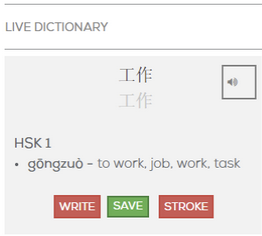
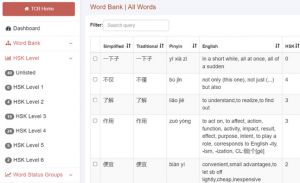
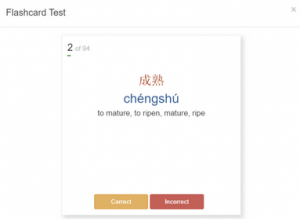
Meanwhile, for enterprising Chinese learners who want to take matters into their own hands, it’s possible to create custom flashcard decks from scratch using an app such as Anki, which is free to download, but requires more time and perseverance to set up.
Grammar and sentence structure
As any seasoned student of Chinese will know, it’s possible to recognise every single word or character in a sentence… and yet still be confused as to what the sentence actually means. That’s why a thorough knowledge of grammar and sentence structures is essential to reading comprehension. Of course, Chinese grammar textbooks are available, but if you prefer to use online tools with interactive features, there are options: Ninchanese for example offers a large collection of interactive grammar and sentence-building lessons, while The Chairman’s Bao has detailed grammar points alongside every Chinese news article, allowing readers to learn grammar in a meaningful context.
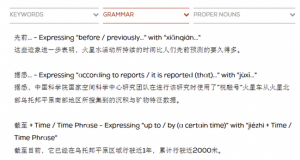
Translation
Sometimes, despite all the tools at our disposal, understanding still eludes us when reading Chinese. That’s when it can be helpful to use translation, from which you can then work backwards to identify the building blocks of the sentence and see how they work together to convey the meaning. One drawback of online translators is that they don’t always produce reliable or natural English output, whereas some Chinese reading tools, such as Du Chinese, do offer a complete English translation (quality-checked by native speakers) as an optional feature. As learners striving to improve our Chinese reading comprehension, we don’t want to depend too heavily on translation, but it can serve its purpose when used wisely.
Exercises for Chinese comprehension practice
Reading Chinese can be an enjoyable and worthwhile endeavour in its own right, regardless of your language learning goals. If your aim is to pass HSK though, you need to be able to answer questions to prove your comprehension of written Chinese – and furthermore, you need to do so under time pressure. That’s why it is highly recommended to do a lot of Chinese comprehension practice exercises as part of your HSK preparation strategy.
If you’re working with a teacher and/or a traditional textbook, you will probably have plenty of opportunities to do reading comprehension activities which will prepare you for the HSK exam. If you are looking to explore online tools, especially for self-study where a teacher’s input may not be required, then The Chairman’s Bao offers user-friendly Chinese reading comprehension challenges which are based on the news articles published to the site daily. Read the article, complete the activities, and get an instant score to show how well you understood the material.
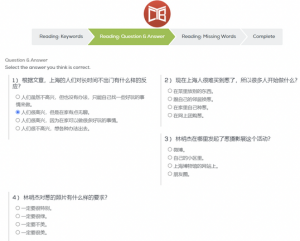
Meanwhile for those who want to dip their toe in the water without committing to a subscription service, the site HSKreading.com offers free HSK reading material with short comprehension activities. Its features are limited, but it could be helpful for those getting started with reading Chinese, and for simple HSK1 reading practice.
Additional Chinese reading material
Graded readers
Reading Chinese texts that you enjoy and understand is a hugely motivating and effective way to enhance your language learning. Select texts that are appropriate for your level, containing a high proportion of familiar words and characters. The book series Mandarin Companion offers a selection of graded readers, including original stories and reworked classics, which are aimed at beginners and those looking for easy Chinese reading material.
Parallel texts
If you’d like to read Chinese with an English translation side-by-side, then parallel texts are for you: in book and e-book format, there are beginner and intermediate-level Chinese story collections published by Lingo Mastery, with accurate English translations. There is also Beelinguapp, a language-learning app offering a variety of Chinese texts with accompanying audio and English translation.
General HSK tips
- Get in your daily Chinese reading practice. If you only have 15 minutes to practise today, then do 15 minutes and use the time efficiently, and aim to do 30 minutes or longer tomorrow. Learning a language – especially one as notoriously challenging as Chinese – requires sincere dedication, motivation and consistency, so you should build reading Chinese into your daily routine.
- Challenge yourself. As your reading fluency improves and you become increasingly adept at completing Chinese comprehension exercises, take your HSK preparation a step further by setting a time limit and working under mock-test conditions. Can you work under time pressure without compromising on accuracy?
- Work with a native Chinese teacher. Find a teacher who is familiar with HSK and can help you prepare for the test. A skilled teacher can provide feedback on your strengths and weaknesses, share their HSK tips for success, and motivate you to continue with your learning. With that said, even the best teacher is not a substitute for putting in the work yourself – so treat your Chinese lessons as just one important element in your HSK preparation strategy, and don’t depend on your teacher to get you through the exam. What is learned in class must also be applied and reviewed regularly outside of the classroom if you are to succeed.
Further HSK resources
- HSK word lists: These are readily available online. It is best to search for “HSK [level] word list [current year]” to find the most up-to-date version.
- HSK practice tests: You can get a feel for the typical HSK questions and format by taking mock tests, which are available on websites such as Mandarin Bean and the official HSK website chinesetest.cn. The latter includes other useful HSK resources and detailed information about the structure of the exam.
Author
Daisy Ward is an experienced online English teacher, writer and content creator with a passion for foreign languages and cultures. Her expertise in effective language-learning strategies is derived from many years in language classrooms, both as a teacher and as a student. Fluent in French and competent in Mandarin Chinese, she attributes much of her success in learning languages to the use of apps and other online tools.
























